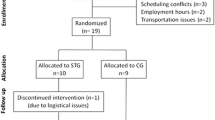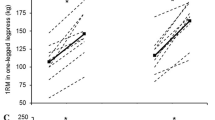Abstract
This study compared the effects of mixed maximal strength and explosive strength training with maximal strength training and explosive strength training combined with endurance training over an 8-week training intervention. Male subjects (age 21–45 years) were divided into three strength training groups, maximal (MAX, n = 11), explosive (EXP, 10) and mixed maximal and explosive (MIX, 9), and a circuit training control group, (CON, 7). Strength training one to two times a week was performed concurrently with endurance training three to four times a week. Significant increases in maximal dynamic strength (1RM), countermovement jump (CMJ), maximal muscle activation during 1RM in MAX and during CMJ in EXP, peak running speed (S peak) and running speed at respiratory compensation threshold (RCTspeed) were observed in MAX, EXP and MIX. Maximal isometric strength and muscle activation, rate of force development (RFD), maximal oxygen uptake \( \left( {\dot{V}{\text{O}}_{2\max } } \right) \) and running economy (RE) at 10 and 12 km hr−1 did not change significantly. No significant changes were observed in CON in maximal isometric strength, RFD, CMJ or muscle activation, and a significant decrease in 1RM was observed in the final 4 weeks of training. RE in CON did not change significantly, but significant increases were observed in S peak, RCTspeed and \( \left( {\dot{V}{\text{O}}_{2\max } } \right). \) Low volume MAX, EXP and MIX strength training combined with higher volume endurance training over an 8-week intervention produced significant gains in strength, power and endurance performance measures of S peak and RCTspeed, but no significant changes were observed between groups.




Similar content being viewed by others
References
Ahtiainen JP, Pakarinen A, Alén M, Kraemer WJ, Häkkinen K (2003) Muscle hypertrophy, hormonal adaptations and strength development during strength training in strength-trained and untrained men. Eur J App Physiol 89:555–563
Aldred S, Rohalu M, Edwards K, Burns V (2009) Altered DHEA and DHEAS response to exercise in healthy older adults. J Aging Phys Act 17(1):77–89
Bell GJ, Syrotuik D, Martin TP, Burnham R, Quinney HA (2000) Effect of concurrent strength and endurance training on skeletal muscle properties and hormone concentrations in humans. Eur J Appl Physiol 81:418–427
Billat LV, Koralsztein JP (1996) Significance of the velocity at VO2max and time to exhaustion at this velocity. Sports Med 22(2):90–108
Bosco C, Komi PV (1978) Utilization of stored elastic energy in leg extensors muscles by men and women. Med Sci Sports Exerc 10:261–265
Consitt LA, Copeland JL, Tremblay MS (2002) Endogenous anabolic hormone responses to endurance versus resistance exercise and training in women. Sports Med 32(1):1–22
Cormie P, McGuigan MR, Newton R (2010) Adaptations in athletic performance after ballistic power versus strength training. Med Sci Sports Exerc 42(8):1582–1598
Hackney AC, Szczepanowska E, Viru AM (2003) Basal testicular testosterone production in endurance-trained males is suppressed. Eur J Appl Physiol 89:198–201
Häkkinen K (1985) Factors influencing trainability of muscular strength during short term and prolonged training. NCSA J 7(2):32–37
Häkkinen K (1994) Neuromuscular adaptation during strength training, aging, detraining, and immobilization. Crit Rev Phys Rehabil Med 6:161–198
Häkkinen K, Komi PV (1981) Effect of different combined concentric and eccentric muscle work regimens on maximal strength development. J Hum Mov Stud 7:33–44
Häkkinen K, Komi PV (1983) Electromyographic changes during strength training and detraining. Med Sci Sports Exerc 15:455–460
Häkkinen K, Komi PV, Alén M (1985) Effect of explosive type strength training on isometric force- and relaxation-time, electromyography and muscle fibre characteristics of leg extensor muscles. Acta Physiol Scand 125:587–600
Häkkinen K, Alen M, Kallinen M, Izquierdo M, Jokelainen K, Lassila H, Mälkiä E, Kraemer W, Newton RU (1998) Muscle CSA, force production and activation of leg extensors during isometric and dynamic actions in middle-aged and elderly men and women. J Aging Phys Activ 6:232–247
Häkkinen K, Alén M, Kraemer WJ, Gorostiaga E, Izquierdo M, Rusko H, Mikkola J, Häkkinen A, Valkeinen H, Kaarakainen E (2003) Neuromusuclar adaptations during concurrent strength and endurance training versus strength training. Eur J Appl Physiol 89:42–52
Helgerud J, Høydal K, Wang E, Karlsen T, Berg P, Bjerkaas M, Simonsen T, Helgesen C, Hjorth N, Bach R, Hoff J (2007) Aerobic high-intensity intervals improve VO2max more than moderate training. Med Sci Sport Excer 39(4):665–671
Hickson RC (1980) Interference of strength development by simultaneously training for strength and endurance. Eur J Appl Physiol 45:255–263
Hoff J, Gran A, Helgerud J (2002) Maximal strength training improves aerobic endurance performance. Scand J Med Sci Sports 12:288–295
Hunter G, Demment R, Miller D (1987) Development of strength and maximum oxygen uptake during simultaneous training for strength and endurance. J Sports Med 27:269–275
Karavirta L, Häkkinen A, Sillanpää E, Garcia-Lopez D, Kauhunen A, Haapasaari A, Alen M, Pakarinen A, Kraemer WJ, Izquierdo M, Gorostiaga E, Häkkinen K (2009) Effects of combined endurance and strength training on muscle strength, power and hypertrophy in 40–67-year-old men. Scand J Med Sci Sports 21(3):402–411
Kraemer WJ, Patton JF, Gordon SE, Harman EA, Deschenes MR, Reynolds K, Newton RU, Triplett NT, Dziados JE (1995) Compatibility of high-intensity strength and endurance training on hormonal and skeletal muscle adaptations. J Appl Physiol 78(3):976–989
Kyröläinen H, Belli A, Komi PV (2001) Biomechanical factors affecting running economy. Med Sci Sports Exerc 33(8):1330–1337
Meyer T, Lucia A, Earnest CP, Kindermann W (2005) A conceptual framework for performance diagnosis and training prescription from submaximal gas exchange parameters—theory and application. Int J Sports Med 26:S38–S48
Mikkola JS, Rusko HK, Nummela AT, Paavolainen LM, Häkkinen K (2007) Concurrent endurance and explosive type strength training increases activations and fast force production of leg extensor muscles in endurance athletes. J Strength Cond Res 21:613–620
Mikkola J, Vesterinen V, Taipale R, Capostagno B, Häkkinen K, Nummela A (2011) Effects of strength training regimens on performance in recreational endurance runners. J Sports Sci 29(13):1359–1371
Nadolnik LI (2011) Stress and the thyroid gland. Biochem Suppl Series B Biomed Chem 5(2):103–112
Newton RC, Kraemer WJ (1994) Developing explosive muscular power: implications for a mixed methods training strategy. NSCAJ 16(5):20–31
Noakes TD, Myburgh KH, Schall R (1990) Peak treadmill running velocity during the VO2max test predicts running performance. J Sports Sci 8:35–45
Paavolainen L, Häkkinen K, Rusko H (1991) Effects of explosive type strength training on physical performance characteristics in cross-country skiers. Eur J Appl Physiol 62:251–255
Paavolainen L, Häkkinen K, Hämäläinen I, Nummela A, Rusko H (1999) Explosive-strength training improves 5-km running time by improving running economy and muscle power. J Appl Physiol 86:1527–1533
Pakarinen A, Alén M, Häkkinen K, Komi P (1988) Serum thyroid hormones, thyrotropin and thyroxine binding globulin during prolonged strength training. Eur J Appl Physiol 57:394–398
Pakarinen A, Häkkinen K, Alén M (1991) Serum thyroid hormones, thyrotropin and thyroxine binding globulin in elite athletes during very intense strength training of one week. J Sports Med Phys Fitness 31(2):142–146
Sillanpää E, Häkkinen A, Nyman K, Mattila M, Cheng S, Karavirta L, Laaksonen DE, Hiihka N, Kraemer WJ, Häkkinen K (2008) Body composition and fitness during strength and/or endurance training in older men. Med Sci Sports Exerc 40(5):950–958
Støren Ø, Helgerud J, Støa EM, Hoff J (2008) Maximal strength training improves running economy in distance runners. Med Sci Sports Exerc 40(6):1087–1092
Taipale RS, Mikkola J, Nummela A, Vesterinen V, Capostangno B, Walker S, Gitonga D, Kraemer WJ, Häkkinen K (2010) Strength training in endurance runners. Int J Sports Med 31(7):468–476
Tremblay MS, Copeland JL, Van Helder W (2005) Influence of exercise duration on post-exercise steroid hormone responses in trained males. Eur J Appl Physiol 94:505–513
Wilson JM, Marin PJ, Rhea MR, Wilson, SMC, Loenneke JP and Anderson JC (2011) Concurrent training: a meta analysis examining interference of aerobic and resistance exercise. J Strength Cond Res (Published ahead of print Oct 13)
Acknowledgments
This study was a cooperative effort between KIHU–Research Institute for Olympic Sport and the Department of Biology of Physical Activity at the University of Jyväskylä. Funding was provided by the Finnish Funding Agency for Technology and Innovation (TEKES), KIHU–the Research Institute for Olympic Sport, the Department of Biology of Physical Activity and the Foundation of Sports. The authors wish to thank the technical staff at KIHU–Research Institute for Olympic Sport (Esa Hynynen and Sirpa Vänttinen) and the Department of Biology of Physical Activity, University of Jyväskylä’s technical staff (Pirkko Puttonen, Risto Puurtinen, Sirpa Roivas and Markku Ruuskanen).
Conflict of interest
None of the authors declare any professional relationships with companies or manufacturers that would benefit from the results of the present study.
Author information
Authors and Affiliations
Corresponding author
Additional information
Communicated by Toshio Moritani.
Rights and permissions
About this article
Cite this article
Taipale, R.S., Mikkola, J., Vesterinen, V. et al. Neuromuscular adaptations during combined strength and endurance training in endurance runners: maximal versus explosive strength training or a mix of both. Eur J Appl Physiol 113, 325–335 (2013). https://doi.org/10.1007/s00421-012-2440-7
Received:
Accepted:
Published:
Issue Date:
DOI: https://doi.org/10.1007/s00421-012-2440-7




